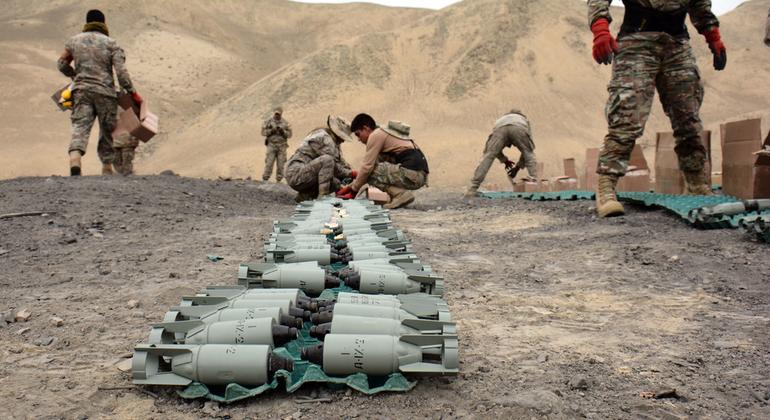Report warns new use of cluster bombs threatens global ban

According to the 100-page Cluster Munition Monitor 2024 Report prepared by the Cluster Munition Coalition, an international civil society group active in more than 100 countries, civilians accounted for 93 percent of global casualties from cluster bombs in 2023.
Children to account for nearly half of deaths and injuries from cluster bomb remnants in 2023
“The actions of countries that fail to ban cluster bombs are endangering civilians and threatens the integrity and universality of the international treaty banning these hideous weapons.”, said Tamar Gabelnick, director of the Cluster Munitions Alliance, who will present the report at the 12th Meeting of States Parties to the Convention. Convention on Cluster Munitions at the United Nations in Geneva from September 10 to 13.
In fact, children accounted for nearly half of those killed and injured by cluster munitions in 2023, and attacks also had a direct and devastating impact on civilian targets, including schools and hospitals, according to the report.
“It is imperative that all States join the Convention on Cluster Munitions and help achieve the goal of ending suffering and death. caused by cluster bombs,” said Mr. Gabelnick.
New violations reported
A total of 112 countries have joined the ban, including South Sudan, the last country to join the convention, which bans cluster munitions and requires the destruction of stockpiles and the clearing of areas contaminated by remnants of cluster munitions — as well as providing risk education and support for victims.
Although there have been no reports or allegations of new use of cluster munitions by any State Party since the convention was adopted in May 2008, these weapons were deployed by Russian and Ukrainian forces in Ukraine in 2023 and up to the time of publication of the latest monitoring report.
The number of manufacturers has increased from 16 to 17 since 2023, with Myanmar now producing cluster munitions along with the Democratic People’s Republic of Korea, South Korea, Brazil, China, Egypt, Greece, India, Iran, Israel, Pakistan, Poland, Romania, Russia, Singapore, Turkey and the United States, none of which are parties to the global treaty.
New uses of these weapons have also been reported in Myanmar and Syria. During the reporting period, the report provides an overview of implementation and compliance with the convention.
Deadly Legacy
Like landmines, cluster bombs leave a deadly legacy long after a battle is over. Many of these submunitions do not explode on initial impact, leaving behind remnants that indiscriminately injure and kill for years until they are cleared and destroyed.
According to the Cluster Bomb Monitoring Report 2024, A total of 28 other countries and areas are contaminated or suspected of being contaminated by cluster munition remnants, including 10 countries that are parties to the convention..
Contamination from cluster bomb remnants makes access to agricultural land dangerous and difficult, further endangering lives and livelihoods in affected areas.
This is particularly notable in Ukraine, where there are indications that agricultural land is contaminated by more cluster munitions than by bombs, anti-personnel mines, and anti-vehicle mines combined.
In war-torn Gaza, which has been bombed daily by Israeli forces for nearly a year, clearing unexploded munitions will take years and cost millions of dollars to make the enclave safe, experts say. speak United Nations News earlier this year.

A UN team inspects an unexploded 1,000-pound bomb lying on a main road in Khan Younis, Gaza.
Alarming consequences and casualties
Cluster bombs cause severe injuries from blast, burns, and fragmentation, leaving most survivors requiring lifelong medical treatment and rehabilitation.
Although there has been some progress in supporting victims, the report states that Significant challenges remain, particularly in countries such as Afghanistan and Lebanon.where the health care system is overwhelmed.
The new report also found that Ukraine records world’s highest annual cluster bomb casualties for second year in a rowAlthough the actual casualties are believed to be significantly higher than the recorded figures.
Cluster bombs have killed and injured more than a thousand people in Ukraine since Russia launched a full-scale invasion of the country in February 2022.
Update on cleanup efforts
The report stated that the area cleared of remaining cluster munitions in 2023 decreased compared to the previous year.
The document also further highlights the need for sustainable funding and support to ensure that contaminated Member States can meet their clearance obligations.
“States that have signed up to the convention face ongoing challenges in clearing land contaminated by cluster bomb remnants due to funding and capacity constraints, as well as difficulties in accessing contaminated areas due to security concerns or difficult terrain,” said Katrin Atkins, editor of the Cluster Bomb Watch’s report on contamination, clearance and risk education.

A bomb disposal officer of the State Emergency Service of Ukraine scans the ground for mines and unexploded ordnance.
Milestone
In August 2023, Bosnia and Herzegovina became the ninth State Party to complete the clearance of cluster munition contaminated areas in accordance with its obligations under the Convention on Cluster Munitions.
The convention reached a major milestone last December when Peru completed the destruction of its cluster munitions stockpile, becoming the last state party to do so.
That means that Member States have now collectively destroyed 100% of their declared cluster munition arsenals, destroying 1.49 million cluster munitions and 179 million submunitions.
New trends are happening
However, Ms Atkins explained that there are alarming developments taking place.
“In many affected member states, more contaminated areas are being discovered even as known areas have been cleaned up,” she said.
Additionally, Lithuania enacted a law in July 2024 approving its withdrawal from the Convention on Cluster Munitions.
The withdrawal will take effect six months after Lithuania takes the withdrawal steps required by the convention, unless the country withdraws this measure or becomes involved in an armed conflict.
QUICK INFORMATION
- Here are some highlights from the latest Cluster Bomb Monitor:
- An annual resolution at the United Nations General Assembly promoting the Convention on Cluster Munitions was adopted by 148 countries in December 2023, including 37 non-signatories. Russia was the only country to vote against it.
- New cluster bomb casualties were recorded in 2023 in nine countries: Azerbaijan, Iraq, Laos, Lebanon, Mauritania, Myanmar, Syria, Ukraine and Yemen.
- Of the total 219 casualties reported in 2023, 118 were due to cluster bomb attacks while 101 were due to cluster bomb remnants.
- Only 10 countries that are parties to the convention retain cluster bombs for permitted research and training purposes, with Germany having the largest number.
- Contaminated Member States reported clearing 83.91 km² of cluster munition-contaminated land in 2023, resulting in the destruction of at least 73,348 cluster munition remnants, primarily unexploded submunitions and unexploded cluster bombs.
- There is evidence of new cluster bomb production in India, Myanmar, Russia and South Korea during the reporting period.
- From July 2023 to April 2024, President Joe Biden approved five transfers to Ukraine of US cluster munitions delivered by 155mm artillery shells and ballistic missiles.
- 33 member states have specific implementing legislation for the convention.
- Another 22 member states are planning or are in the process of drafting, considering or adopting specific legislative measures to implement the convention, while 43 member states consider their existing laws and regulations to be sufficient.


